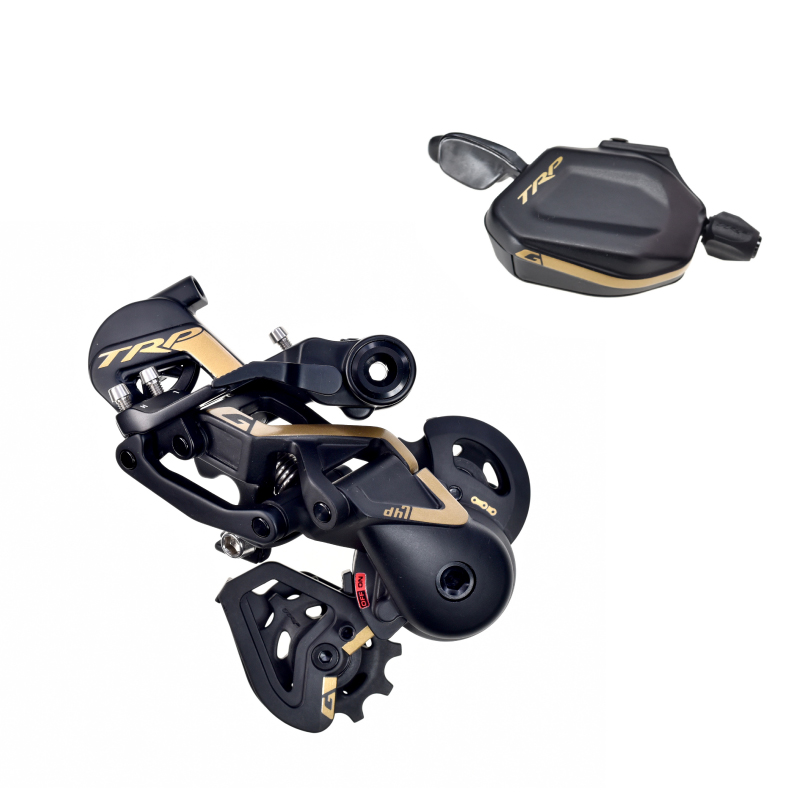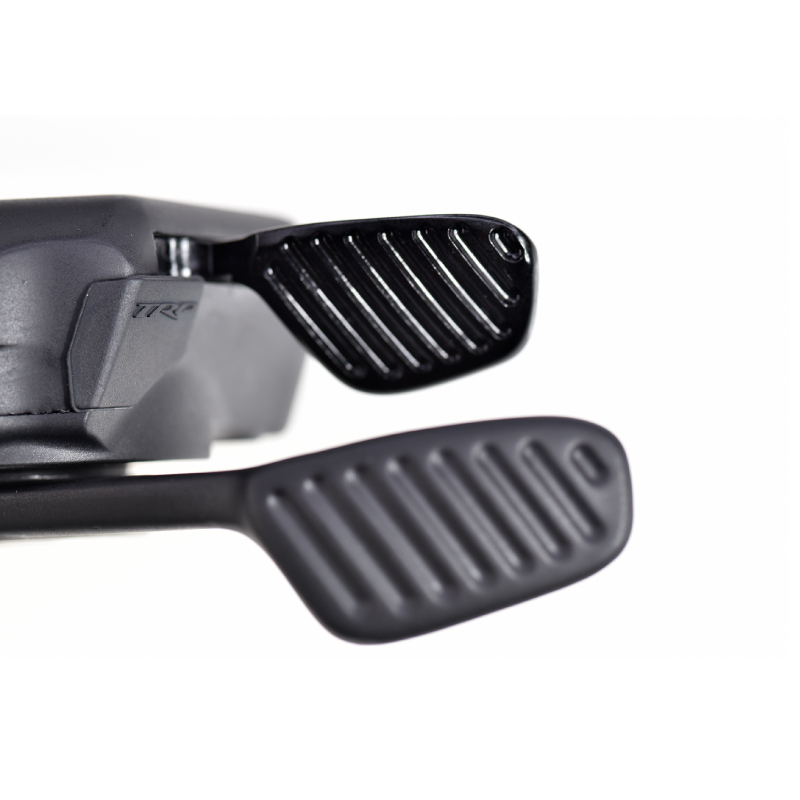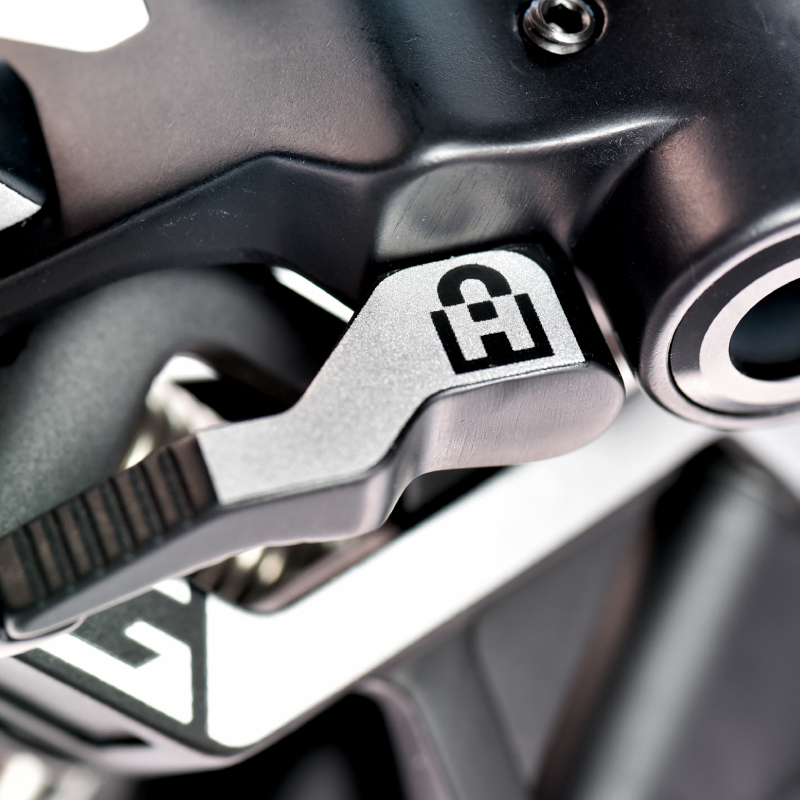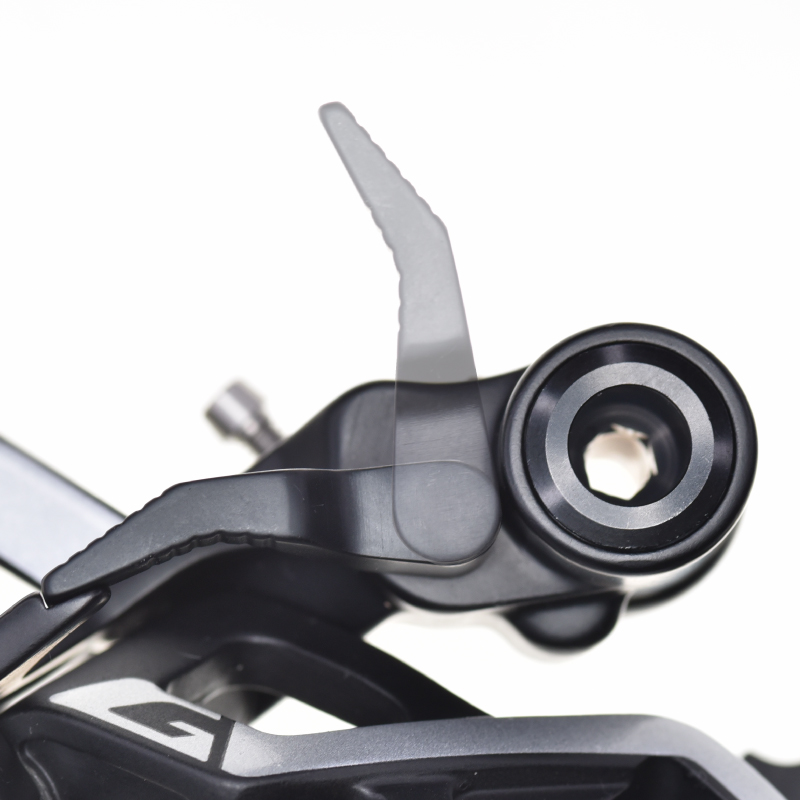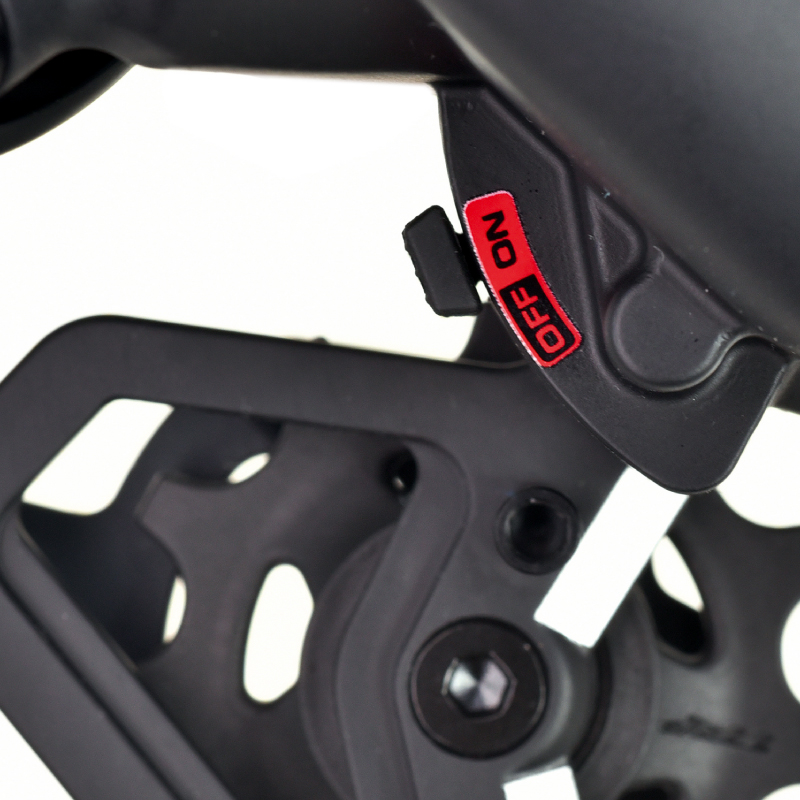Description
Product

Derailleur: The ongoing competition amongst the best mechanics in the world during a World Cup season is to build the quietest bike on the track. John Hall identified the movement of the derailleur around the B-knuckle as one of the points for improvement. This inspired John‘s idea to lock the B-knuckle to the bike‘s derailleur hanger.
• Hall Lock
• G-Spec Ratchet Clutch
• G-Spec finishing touches:
• Carbon fiber cage & Upper link
• Extra wide parallelogram pivot
• Sealed cartridge bearings pulleys
Shifter: Ergonomics are key to Aaron and he wanted something different for a reason. In addition to adjustability, TRP engineers looked at the cable release lever’s ergonomics and devised a system to move it in a linear path to mimic the motion of a rider’s thumb rather than rotating away.
• Shift levers designed and located for optimum performance by Aaron Gwin
• Enhanced grip & tactile feel built into lever paddles: embossed grooves on advance and release lever
• Carbon fiber upper housing & advance lever position with brake lever
• Ball bearing equipped
• 7 speed
• Tool-free straight lace cable changes
• Rider adjustable home position of lower lever with a 40-degree range
All information subject to change
DATASHEET » | FLYER » | STORYBOOK »
The Story
“AARON AND JOHN KNEW EXACTLY WHAT THEY WANTED.”

“It is a pretty complicated project to make a derailleur – there are a lot of patents and all kind of things you have to work around, so you’ve got to be really kind of innovative to find your own way to do things and also to make it better. The thing I enjoyed most working with the TRP crew, is their trust in John and I, their believe and vice versa.” –Aaron Gwin
“The end result of improvement, whether it is a product, whether it is results, just elevating the game in all areas – that’s what really drives me. Take a chance on it, it is pretty cool how the product grows on you and it becomes yours – you’ll be blown away.” -John Hall
Aaron and his mechanic John Hall are constantly pushing and challenging the TRP Team – this is why we like working with them. 2016 and 2017, Aaron Gwin won two of his five DH WorldCup overall titles on TRP brakes.
Technologies
“IT PREVENTS YOUR DERAILLEUR FROM LIFTING, SLAPPING AND MAKING A TON OF NOISE”

TRP engineers worked closely with John Hall to create the Hall Lock. A Lever integrated into the B-knuckle mount, which can be opened or closed, as needed. For working on the derailleur or changing the wheel, the Hall Lock is opened. When locked, the derailleur is stabilized for the roughest conditions. This feature helps maintain the utmost accuracy in shifting and superb chain retention. Its clamping force can be adjusted to balance stability and security with the derailleur’s ability to deflect on impact.
• Hall Lock is an on/off feature with adjustable force that brings TRP’s derailleurs the utmost stability, accuracy, chain retention and quietness in operation for mountain biking’s roughest conditions
• It can lock-out the main pivot bolt to prevent your derailleur from lifting, slapping and making noise
• You can set it up however you like – if you want maximum stability you can lock it; if you like it to move like a standard derailleur you can adjust it to do so

The second derailleur feature is a ratchet style clutch, which is adjustable. Depending on a full suspension bike’s design, there can be enough chain growth to feel resistance from the clutch. If a rider wants to free up the system up, he or she can back off the clutch to balance pedal feedback with the clutch’s chain retaining properties.
• Large diameter clutch surfaces for wear resistance and predictable force generation
• Oversized friction surface area for consistent force output
• Adjustable clutch force provides a wide range of customizable ride tuning and compensation for wear
• Quick and easy on/off switch removes all clutch force when needed for wheel changes
• Robust pawl engagement

• Indicators printed on the knuckle and the cage for easy viewing
• This marking helps ensure a quick and accurate measure of the system’s required chain length

Shop mechanics and home wrenches both will appreciate when components can be set up quickly and smart. Saving time for set-up and providing an easy check for assurance.
• Marking aids help mechanics and riders in setting up the B-Adjustment gap and ensures that an accurate adjustment can be made quickly and without special tools
All information subject to change
Watch the Video
Setup and Hall’s Hacks
ABOUT JOHN HALL – INTENSE FACTORY RACING LEAD MECHANIC
For the last five years John Hall has been responsible for every bolt on Aaron‘s bike. He grew up working on his family’s ranch in South Dakota, where hard work is the norm. That said, he’s the first one to work smarter rather than harder. “You don’t want to be jacking around with all of the little things all the time, there are enough things on a race weekend,” says Hall. “You just want to be able to do a quick once over and ride.”
With this in mind, here are John Hall’s TRP derailleur hacks:
Ratchet Clutch
You shouldn’t need to adjust the TRP ratchet clutch when it’s new. “More times than not, I will wait until the clutch is worn before I make an adjustment to tighten it up. The factory setting is perfectly fine.”
Hall Lock
Alert – Always have the Hall Lock lever open when installing the derailleur; working on it or changing the wheel – thank you.
Out of the box the Hall Lock is loose and should be adjusted. “After I have installed the derailleur and get everything adjusted. I tighten the set screw to the point where it stops itself,” says Hall. “I want it to be as tight as it can be, while still being able to operate the Hall Lock lever with my fingers. That seems to be a really good spot. It keeps everything good and tight and the noise down, but when it takes a hit from a rock it doesn’t have so much tension that it can’t move out of the way.”
Proper Chain Length
When sizing the chain, John suggests that you, “Run the chain around the smallest cog on the cassette through the derailleur and then use the closest link that adds a little bit of pressure onto the clutch.”
Lock Adjustments
When using the Clutch and Hall Lock adjustments, less is more – “The smaller you make your adjustments the better,” says Hall. “If you think you need to do a 30 degree turn, do a 15 degree of a turn, especially on the clutch because there are two screws that you adjust, so when you do a 15 degree of a turn on each, that essentially turns into an 30 degree of a turn on the whole system, which is a lot. Out of the box you shouldn’t have to adjust it. The only time you want to touch it is as it wears—you can bring it back to life by adding a little bit of tension, which just extends the longevity of your whole clutch system.”
Reset Hall Lock
What can go wrong? Reset the Hall Lock after an impact – If you crash or you hit your TRP derailleur on a rock when riding the Hall Lock is meant to move, even if it’s engaged, in order to prevent catastrophic damage to the derailleur. If this happens, it’s important to take an extra step before you jump back on and ride. “Always be sure to release the Hall Lock and allow that derailleur B-screw to drop back down to the B-plate before you turn your Hall Lock back on,” says Hall. “In this rare scenario, if you just push your derailleur back into place with the Hall Lock on, you can actually loosen that derailleur mounting bolt. We may talk about this a lot, but I’ve actually never hit this derailleur hard enough to push it off the B-plate. It’s just one of those things to know, in the rare case it does happen, that you don’t want to just shove your derailleur back down without turning the Hall Lock off.”

